
Invasion of the Dinosaurs, simply titled Invasion in Part One, is the second serial of the 11th season of the British science fiction television series Doctor Who, which was first broadcast in six weekly parts on BBC1 from 12 January to 16 February 1974.

Walking with Dinosaurs is a 1999 six-part nature documentary television miniseries created by Tim Haines and produced by the BBC Science Unit, the Discovery Channel and BBC Worldwide, in association with TV Asahi, ProSieben and France 3. Envisioned as the first "Natural History of Dinosaurs", Walking with Dinosaurs depicts dinosaurs and other Mesozoic animals as living animals in the style of a traditional nature documentary. The series first aired on the BBC in the United Kingdom in 1999 with narration by Kenneth Branagh. The series was subsequently aired in North America on the Discovery Channel in 2000, with Avery Brooks replacing Branagh.
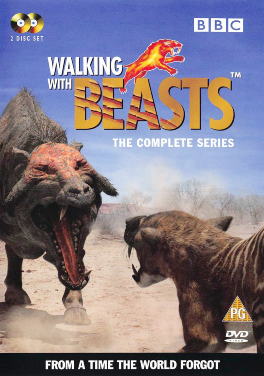
Walking with Beasts, marketed as Walking with Prehistoric Beasts in North America, is a 2001 six-part nature documentary television miniseries created by Impossible Pictures and produced by the BBC Science Unit, the Discovery Channel, ProSieben and TV Asahi. The sequel to the 1999 miniseries Walking with Dinosaurs, Walking with Beasts explores the life in the Cenozoic era, after the extinction of the non-avian dinosaurs, particularly focusing on the rise of the mammals to dominance. The UK version of the series is narrated by Kenneth Branagh, who also narrated Walking with Dinosaurs, and the US version is narrated by Stockard Channing.

Doctor Who Confidential is a documentary series created by the British Broadcasting Corporation (BBC) to complement the revival of the long-running British science fiction television series Doctor Who. Each episode was broadcast on BBC Three on Saturdays, immediately after the broadcast of the weekly television episode on BBC One. The first and second series episodes ran 30 minutes each; third series instalments ran 45 minutes. BBC Three also broadcast a cut-down edition of the programme, lasting 15 minutes, shown after the repeats on Sundays and Fridays and after the weekday evening repeats of earlier seasons. Confidential received its own version of the Doctor Who theme tune, at least three different versions of the theme appeared in the series.

Sea Monsters, marketed as Chased by Sea Monsters in the United States, is a 2003 three-part nature documentary television miniseries created by Impossible Pictures and produced by the BBC Studios Science Unit, the Discovery Channel and ProSieben. Following in the footsteps of The Giant Claw (2002) and Land of Giants (2003), special episodes of the nature documentary series Walking with Dinosaurs, Sea Monsters stars British wildlife presenter Nigel Marven as a "time-travelling zoologist" who travels to seven different periods of time in prehistory, diving in the "seven deadliest seas of all time" and encountering and interacting with the prehistoric creatures who inhabit them. The series is narrated by Karen Hayley.

Walking with Monsters – Life Before Dinosaurs, marketed as Before the Dinosaurs – Walking with Monsters in North America, is a 2005 three-part nature documentary television miniseries created by Impossible Pictures and produced by the BBC Studios Science Unit, the Discovery Channel, ProSieben and France 3. Walking with Monsters explores life in the Paleozoic era, showcasing the early development of groups such as arthropods, fish, amphibians, reptiles and synapsids. Like its predecessors Walking with Dinosaurs (1999) and Walking with Beasts (2001), Walking with Monsters is narrated by Kenneth Branagh.

A nature documentary or wildlife documentary is a genre of documentary film or series about animals, plants, or other non-human living creatures. Nature documentaries usually concentrate on video taken in the subject's natural habitat, but often including footage of trained and captive animals, too. Sometimes they are about wildlife or ecosystems in relationship to human beings. Such programmes are most frequently made for television, particularly for public broadcasting channels, but some are also made for the cinema. The proliferation of this genre occurred almost simultaneously alongside the production of similar television series which is distributed across the world.

The Lost World is a 2001 British made-for-television film adaptation of the 1912 novel of the same name by Arthur Conan Doyle, directed by Stuart Orme and adapted by Tony Mulholland and Adrian Hodges. It was filmed at various locations on the West Coast of New Zealand. The 145-minute film was divided into two 75-minute episodes when broadcast on BBC One on 25 and 26 December 2001, receiving 8.68 million and 6.98 million viewers respectively. Bob Hoskins played Professor Challenger and was supported by James Fox, Peter Falk, Matthew Rhys, Tom Ward and Elaine Cassidy.

Primeval is a British science-fiction television series produced for ITV by Impossible Pictures. Primeval follows a team of scientists tasked with investigating the appearance of temporal anomalies across the United Kingdom through which prehistoric and futuristic creatures enter the present, while simultaneously trying to stop a terrorist plot to bring about the end of the world. Primeval was created by Tim Haines, who previously created the Walking with... documentary series, and Adrian Hodges. It ran for five series, originally broadcast from 2007 to 2011.

Nigel Alan Marven is a British wildlife TV presenter, naturalist, conservationist, author, and television producer. He is best known as presenter of the BBC miniseries Chased by Dinosaurs, its sequel, Sea Monsters, as well as the ITV miniseries Prehistoric Park. He is also known for his unorthodox, spontaneous, and daring style of presenting wildlife documentaries as well as for including factual knowledge in the proceedings.

Neil Nightingale is a British freelance wildlife filmmaker, executive producer and creative consultant with over 35 years experience at the BBC. From 2009 to 2018 he was the creative director of BBC Earth, BBC Worldwide's global brand for all BBC nature and science content.

Land of Giants and The Giant Claw, marketed together as Chased by Dinosaurs in the United States, are two special episodes of the nature documentary television series Walking with Dinosaurs. Created by Impossible Pictures and produced by the BBC Studios Science Unit, the Discovery Channel and ProSieben, The Giant Claw was first broadcast on 30 December 2002, followed by Land of Giants on 1 January 2003. The two episodes stars British wildlife presenter Nigel Marven as a "time-travelling zoologist", interacting with dinosaurs and other prehistoric creatures, a drastic change in presentation from preceding entries in the Walking with... franchise.
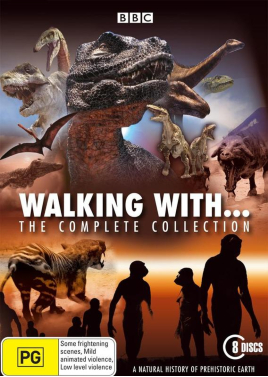
Walking with... is a palaeontology media franchise produced and broadcast by the BBC Studios Science Unit. The franchise began with the series Walking with Dinosaurs (1999), created by Tim Haines. By far the most watched science programme in British television during the 20th century, Walking with Dinosaurs spawned companion material and four sequel series: Walking with Beasts (2001), Walking with Cavemen (2003), Sea Monsters (2003) and Walking with Monsters (2005). Each series uses a combination of computer-generated imagery and animatronics, incorporated with live action footage shot at various locations, to portray prehistoric animals in the style of a traditional nature documentary.
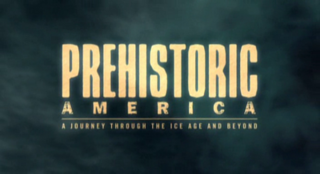
Wild New World is a six-part BBC documentary series about Ice Age America that describes the prehistory, landscape and wildlife of the continent from the arrival of humans to the welcome of the Ice Age. It was first transmitted in the UK & JP on BBC Two from 3 October to 7 November 2002. Like several other BBC programmes, it contains both computer graphics and real-life animals. Occasionally, footage of non-American counterparts of the extinct North American beasts are used in juxtaposition with footage of native American animals, like the pronghorn.
Deadly... is a strand of British wildlife documentary programming aimed principally at children and young people, which is broadcast on CBBC on BBC One and Two and on the CBBC Channel. It is presented by Steve Backshall, with Naomi Wilkinson as co-host on Live 'n Deadly, and Barney Harwood as co-host on Natural Born Hunters. The strand began with a single series known as Deadly 60, and has subsequently expanded into a number of spin-offs, re-edits and follow-up versions.
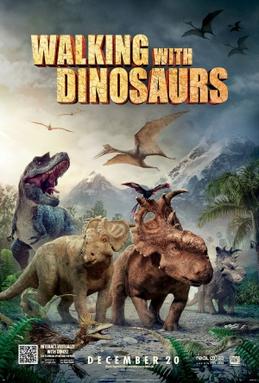
Walking with Dinosaurs is a 2013 live-action/animated family film about dinosaurs set in the Late Cretaceous period, 70 million years ago. The production features animated dinosaurs in live-action settings with actors John Leguizamo, Justin Long, Tiya Sircar, and Skyler Stone providing voice-overs for the main characters. It was directed by Neil Nightingale and Barry Cook from a screenplay by John Collee. In the film, an underdog dinosaur named Patchi must find his courage to become the leader of his herd as well as become a hero for the ages.

Dinosaur Revolution is a four-part American nature documentary produced by Creative Differences. It utilizes computer-generated imagery to portray dinosaurs and other animals from the Mesozoic era. The program was originally aired on the Discovery Channel and Science.
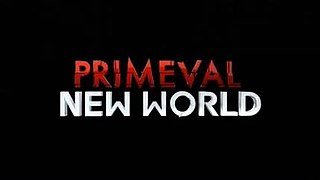
Primeval: New World is a science fiction television program, set in Vancouver, British Columbia, created by Judith and Garfield Reeves-Stevens. A co-production between Britain's Impossible Pictures and Canada's Omni Film Productions, for Space. The series is a spinoff of the British series Primeval. However, the two shows have little to do with each other. It was broadcast on Space in Canada, and on Watch in the United Kingdom. As with Primeval, the premise of Primeval: New World involves a team who has to deal with animals from the past and future that travel through time to the present day through anomalies. On 21 February 2013, it was announced that the series had been cancelled after a single season.

BBC Earth is a brand used by BBC Studios since 2009 to market and distribute the BBC's natural history content to countries other than the United Kingdom. BBC Studios is the commercial arm of the public service broadcaster.
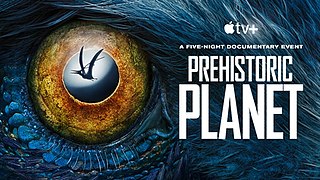
Prehistoric Planet is a British–American nature documentary television series about dinosaurs, that premiered on Apple TV+ beginning May 23, 2022. It is produced by the BBC Studios Natural History Unit, with Jon Favreau as showrunner, visual effects by MPC, and narration by natural historian Sir David Attenborough. The documentary follows dinosaurs and other prehistoric animals recreated with computer-generated imagery, living around the globe in the Late Cretaceous period 66 million years ago (Maastrichtian), just before the dinosaurs' extinction. It set out to depict prehistoric life using current palaeontological research by including accurately feathered dinosaurs, and speculative animal behaviour.


















